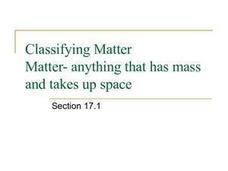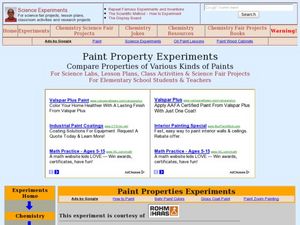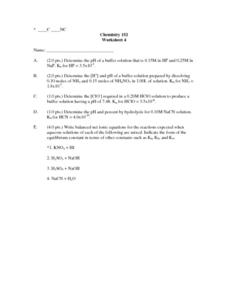Curated OER
Matter
In a neat and straightforward manner, this PowerPoint delivers basic introductory information on the properties of matter, physical and chemical changes, and pure substances vs. mixtures. It also defines the states of matter. For some...
Curated OER
Heating and Cooling Curves
High schoolers experiment with a pure substance and a phase change. In this heating and cooling curves lesson plan, students study the effects of heating and cooling a pure substance to observe a phase change. They determine both the...
Curated OER
Classifying Matter
Details about matter and how it is classified are included here. The slides, with differences about homogenous and heterogeneous mixtures, have diagrams to support the definitions and your class will appreciate the summaries to assist...
Curated OER
Percentage Composition
For this chemistry worksheet, students find the formula weight for each of the substances listed on the sheet. Then they find the percentage composition as indicated.
Curated OER
Paint Property Experiments
Students identify various kinds of paints by using the scientific method. In this solvents lesson students collect data and identify paint samples while working in teams.
Curated OER
Jeopardy 8th Grade (Science)
There are so many topics touched upon in this Jeopardy-style science game, that it is difficult to classify! The categories include electricity, matter, ecology, earth and space, and scientific investigation. This would best be used at...
Curated OER
Density
In this biology worksheet, students use the given clues at the bottom of the sheet to solve the crossword puzzle on density. They identify how density in mass is divided. Students also measure the density of water in grams.
Curated OER
The Electric Sieve
Students examine different mixtures and how they can be separated. In this electric sieve lesson students complete an activity that allows them to separate mixtures.
Curated OER
Elements, Compounds, and Mixtures
In this elements, compounds, and mixtures worksheet, learners answer questions about the properties of elements, mixtures, and compounds. Students identify the physical changes that is made to a substance to determine if it is an element.
Curated OER
Chemistry Worksheet 4
In this chemistry learning exercise, students determine the pH of a buffer solution to several problems given. Students write a balanced ionic equation for several aqueous solutions.
Curated OER
Freezing and Boiling Point
In this freezing and boiling point graph worksheet, students use the graph illustrated to respond to several questions that follow. They identify what is the freezing, boiling, and melting point of the substance in the graph. Students...
Curated OER
Science Safety Rules
In this chemistry worksheet, students read the paragraphs on the sheet to locate the broken safety rules. Then they underline each one of these and count how many they found.
Curated OER
Density Worksheet
In this chemistry worksheet, students identify and describe that density is the ratio of the mass of the substance to the volume of the substance at a given temperature. They also respond to various questions that refer to density in...
Curated OER
Chemistry Worksheet 3
In this chemistry instructional activity, students determine the pH of several given solutions. Students label indicated substances as either acids or bases according to Bronsted-Lowry theory.
Curated OER
Making Sense of Density
Students identify the concepts of density, mass, and volume that define the property of a substance. They also determine that the properties of materials, such as, density and volume, can be compared and measured by using rulers,...
Curated OER
FAT FOLLIES
Students, testing various foods for fat content by rubbing food samples on paper. Students identify what and who the US Food and Drug Administration is in reference to the Food Pyramid. Students write the name of each food brought in to...
Georgia Department of Education
Ga Virtual Learning: Chemistry: Solutions
In this module, students study solutions; how they are formed, how to calculate concentration of solutions, and what the colligative properties of solutions are.
American Chemical Society
American Chemical Society: Hompage
ChemCenter, available from the American Chemical Society, provides chemistry news, reference sources and other public services.
Other
Dea: Just Think Twice
The Drug Enforcement Administration website provides several sections of information designed to help teenagers and parents to get the facts about drugs in our society.
Other
Natural Philosophy: Substance and Accident
Describes Aristotle's distinction between substance and accident. Lists the various types of "accident" as conceived by Aristotle.
American Chemical Society
Middle School Chemistry: Using Dissolving to Identify an Unknown
See how using the process of dissolving can be used to identify an unknown substance.
CK-12 Foundation
Ck 12: Chemistry: Elements
[Free Registration/Login may be required to access all resource tools.] Covers element and properties of an element.
Philosophy Pages
Philosophy Pages: Aristotle (384 322 Bce)
The life, philosophy and metaphysics of Aristotle (384-322 BCE) are surveyed. The aim of Aristotle's logical treatises (known as the Organon) was to develop a universal method of reasoning by means of which it would be possible to learn...























